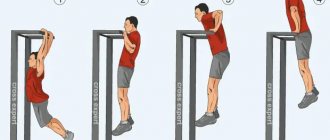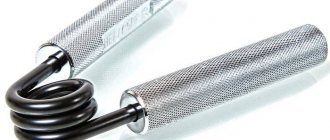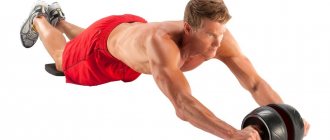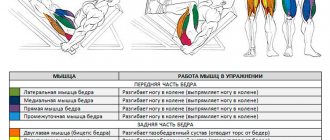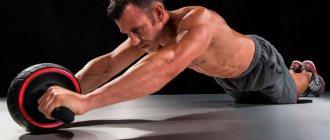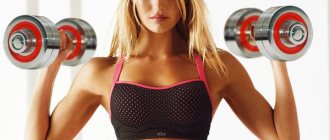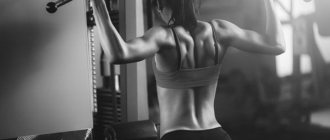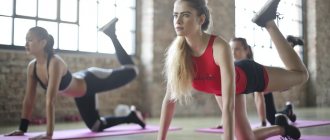November 27, 2022 Admin Home page » Tips and tricks
Add variety to your workout by adding gymnastic rings. What are the benefits of gymnast training and is it even worth paying attention to?!
Everyone has seen gymnasts at the Olympic Games who, using gymnastic rings, create miracles of acrobatics and muscular endurance. At the same time, athletes have not only beautifully drawn muscles and disproportionately developed arms, but also well-strengthened ligaments and tendons.
To the untrained, exercises on gymnastic rings will seem mega difficult, and this is not surprising, because you need to learn how to maintain body balance and have good muscle coordination. Despite this, after a certain amount of training, everything that seemed difficult and impossible will seem quite realistic.
It is worth noting that training on gymnastic rings perfectly develops the upper body and strengthens the core muscles. If you still doubt whether this innovation should be introduced into your arsenal of exercises, then look at the benefits you will get from such exercises.
What are gymnastic rings?
Rings are an apparatus in the men's artistic gymnastics competition program. It is presented in the form of two rings suspended using special cables.
In accordance with the international rules of gymnastics, the correct location of the projectile suspension point is 5.75 m above the floor, the rings are at a height of 2.75 m. The distance between the rings from each other at rest should be 50 cm. The diameter inside is 18 cm.
Exercises performed on the apparatus are lifts, stops, revolutions and twists. Elements consist of static and dynamic. The performance ends with an acrobatic dismount. Gymnasts are required to have great physical strength. Some static exercises are more difficult in terms of strength compared to dynamic ones.
A static element held for two seconds is counted. The most famous and difficult of them:
- “Cross” is an element during which the athlete hangs motionless with his arms outstretched horizontally.
- “Airplane” is a support that involves spreading your arms and keeping your body in the same plane with the rings.
- “Reverse plane” is a balance exercise: the body is positioned in a plane with rings, arms are spread out, and the back is turned to the floor.
The judges evaluate the degree of difficulty and cleanliness of each element, as well as how well the dismount is performed.
Specifics of training
Training in exercises on the rings begins with practicing simple elements (hangs, stops, swinging, simple dismounts) with a gradual transition to performing complex combinations.
At the initial stage, training is carried out on low rings; the height of the rings from the floor is changed as necessary. The maximum height from the floor is 280 cm. While practicing complex elements, the gymnast is supported by a coach, and safety structures (longes) are additionally used.
When performing exercises on gymnastic rings incorrectly, the rings sway violently, and the athlete fails to cope with the task of holding the rings. Therefore, in the first lessons, the coach teaches the students the skills of preventing and stopping the swinging of the rings.
To stop the unwanted swinging of the rings, it is necessary to move your legs and torso in the direction opposite to the direction of swinging.
Gymnastic rings. Where to begin?
Safety precautions
The likelihood of injury while performing exercises on the rings depends on ignorance or unwillingness to follow the safety rules for an athlete during training, on the correct installation of equipment and other ancillary equipment.
Basic requirements for installing gymnastic equipment:
- Before installation, check the technical documentation of the projectile.
- Once a year, test the strength of the installation and its parts.
- Hang the rings so that when performing the exercises, the light does not fall into the eyes of the practitioner. The gymnast must clearly see the apparatus and the landing site during dismounts.
- When hanging the rings, set the height in accordance with the height of the students.
- Check the condition of the cables, belts and buckles, the reliability of fastening, and the presence of cracks on the rings.
- Periodically check the strength of the blocks’ fastening to the ceiling.
- Place mats that are smooth and free of bumps without gaps. Take into account that the landing should be in the middle of one of them and the possibility of the practitioners falling.
- The surface of the rings must be smooth, without cracks or chips, and free of magnesium.
Additional inventory
Training requires special gloves that ensure a secure hold of the rings and prevent injury to the skin of the hands due to friction. Gloves are not required if the apparatus is used for the purpose of general physical development, including the development of muscles and flexibility. A soft mat with a significant area is also required. It spreads under the apparatus and is necessary to prevent the gymnast from getting injured when falling. In addition, the mat reduces the stress on the joints during a dismount.
What is stagnation?
Athletes who work out in fitness clubs with an abundance of exercise machines and standard equipment and those who work out on horizontal bars and parallel bars in the yards or at home, on the way to achieving heroic shoulders and chests, sooner or later, approximately equally encounter the phenomenon of stagnation . What does this mean?
There comes a time when, using one or another training method and exercise to achieve the shoulders of your dreams, you realize that the growth in results is practically zero, or the progress has stopped altogether. Objectively, this is expressed in the quantitative indicators of the workout: you are “stuck” either on the same weight, for example, in the exercise bench press or dumbbell fly, or on the same number of repetitions – in push-ups or parallel bars. What can you change in your training to achieve your goal?
Materials for making a projectile
The most common types are wooden, plastic and metal rings. They differ in properties and cost.
The wooden apparatus is pleasant to touch, but there are restrictions regarding the weight of the athlete. Such rings can withstand up to 80 kg. It is necessary to take into account the fact that the loads during jerks increase significantly. Wooden rings are suitable for children and are also suitable for simple exercises without jerking.
If the choice fell on a wooden projectile, then you should purchase products from well-known brands. Conscientious manufacturers use high quality wood and test the rings for tensile strength by subjecting them to a large mass.
Plastic rings are the most popular. Their surface often has convex lines or dots. They provide a strong grip on the projectile, as they prevent hands from slipping. Compared to wood, plastic is more uniform. In this regard, rupture of such rings during normal use within the permissible load is impossible. Professional athletes do not use a projectile that has a relief, because it creates difficulties when intercepting the ring.
Metal shells are the strongest and heaviest. They have a thick layer of rubber coating that prevents palms from slipping. Typically used by weightlifters developing endurance. Metal rings are purchased for workout classes. The body weight of athletes in this discipline often exceeds 100 kg.
As for cable materials, the more elastic it is, the easier it is to perform dynamic exercises. It pulls the athlete up, throws him up and thereby reduces the load on the muscles. During competitions, professional gymnasts use a steel cable whose elasticity is zero. The athlete’s contact with the cable is eliminated due to the rigid textile belt. It connects the cable to the rings. An amateur projectile is suspended on a cord.
Vis
The hang is a basic static exercise, performed with a simple and deep grip. A simple hang serves as the starting position for many exercises; in the middle of the combination it acts as an independent element. A mixed hang is done with the help of additional support on the apparatus or the floor by any part of the body. The exercise begins to be learned on low rings until the gymnast has complete control of balance.
Correct hanging is characterized by:
- the body is straightened in all joints;
- the head is between the hands;
- the stomach is tucked;
- legs joined together;
- socks pulled down;
- the hands are pronated;
- the rings are parallel or turned inward.
Types of hanging
- Hangs standing, lying down, crouching - on low rings.
- Hanging with a veil on your hand.
- Hanging bent over with your toes into the rings.
- Hanging like a veil in the rings.
- Hanging with a curtain in a ring, letting go of your hands.
- Hanging with straight arms.
- Hanging on bent arms.
- Hanging bent over.
- Hanging with the support of your feet on the cables.
- Hanging over.
- Hanging from behind.
- Hanging at an angle.
Hanging with bent arms is characterized by extreme bending of the arms, the hands are turned and the fingers are pressed to the chest.
Hanging bent over, hanging from behind, hanging bent over
Bent over hang technique :
- Performed from swinging while hanging.
- Push off with force with both legs, swing with one and push with the other, forcefully.
- The rings are parallel to the body.
- While hanging, the arms should be straight, the head tilted to the chest, the legs straight and raised to a bent position at an angle of 45° to the longitudinal axis of the body, the GCM (common center of mass) of the body is in the plane of the cables.
From a hanging bent position the following are performed:
- hanging from behind - the legs and torso are lowered to the limit back and down. To perform this exercise, the gymnast must have good muscle strength and mobility in the shoulder joints.
- hanging bent over . It is characterized by a slightly arched or straight body, head down, arms straight, rings pressed to the body, pelvis in the plane of the rings, heels and head on the same line.
Horizontal back hang
Used as an independent exercise to develop muscle strength. In terms of execution technique, it is classified as a simple element. It is characterized by - the body is located in a horizontal position in a hanging position from behind, the rings are turned outward, the arms are supinated and in contact with the latissimus dorsi muscles, the head is slightly raised. To perform a horizontal back hang, the gymnast must have well-prepared muscles for strength training in the neck, back, hamstrings, and hands.
Horizontal front hang
It is considered the most difficult strength exercise. During the exercise, the muscles involved are the pectoral, gluteal, latissimus dorsi, abdominal, iliopsoas, anterior and inner thigh muscles. This type of hang is included in the program of gymnasts with a high sports rank. The characteristic feature of a hang is that the body is positioned horizontally, the arms are straightened at the elbow joints, the head and torso form a straight line, the rings are turned inward - the thumbs are facing each other, the hands slightly squeeze the rings, the support is mainly on the fingers.
Gymnastic rings. Level No. 2.
Ring program structure
Group 1 includes twists, large and double turns, and various lifts. Lifting allows the athlete to change position (hanging on the emphasis).
Group 2 included lifts through a backswing and a flip into a stance, as well as high revolutions.
Group 3 is a complex of complex flywheel elements, consisting of a high angle, a cross and horizontal stops.
Group 4 is a set of all static elements: corners, crosses, horizontal stops and hangers. This includes a complex of power lifting and lowering.
A dismount, representing a vertical somersault, completes the performance.
Swinging and swinging exercises
Swinging is an integral part of all compound swing exercises. The gymnast is required to perform precise coordinated actions. The slightest inaccuracy in the athlete’s actions leads to failure to complete the exercise as a whole.
Swinging while hanging
- Performed by successive swings of the body and legs.
- When swinging forward, the rings actively move backwards, and when swinging backwards, they move forward.
- When swinging, the GCM of the body is always located on the vertical, passing through the points of attachment of the rings.
- During the forward swing, at the moment the body passes the vertical, an energetic throwing movement is made with the legs and torso forward and upward, the GCM rises to the greatest possible height, and at the end point of the forward swing, the rings are retracted as far back as possible behind the head.
- From this position, the back swing begins with the back and pelvis, with some lag of the legs.
- When passing the vertical, the legs catch up with the body and are pulled back with an energetic throwing movement, overtaking the body, the GCM of the gymnast’s body reaches its highest point, straight arms are extended forward and actively press on the rings. Then the forward swing begins.
- Active back and forth movements of the arms provide constant tension on the rings, necessary for effective swinging.
Twist forward from a bent hang
- Performed only with a backward swing.
- After the body passes the vertical, a whipping movement is immediately made with the legs back and up.
- Hands gradually spread to the sides, press on the rings and turn outward.
- The shoulders move forward, the head is pulled back.
- At the end of the swing, when the GCM is above the horizontal, a twist is made in the shoulder joints.
- The exercise ends with a hanging bend and arch.
Lessons for beginners
Beginners can use professional equipment, as well as homemade ones. The rings are attached to ropes. You can hang the apparatus on a horizontal bar, a gymnastics wall, or even on a tree. Exercises are allowed not only at home and in the gym, but also in the fresh air.
Elementary exercises are suitable for beginner gymnasts:
- Push-ups are the same as on the floor, only with rings in your hands (they need to be lowered to the floor). This is difficult, so first you can raise the projectile to your waist. Then the load is increased by raising the legs above the level of the arms. The duration of the “plank” - emphasis without movement - is increased to three minutes. Care must be taken as the heart muscle is stressed.
- The pull-up on the rings is similar to the pull-up on the bar. You need to hold the rings without moving. The legs are on the floor, the body is kept straight and motionless, trying to touch the projectile with the chest.
- Raising your legs while hanging builds your abs. First, the limbs are raised with bent knees, then straight.
The cross is a very difficult exercise, it is performed by professionals. But no one forbids beginning gymnasts from trying to master it, because they need to start sometime. This static element is also called the “Azaryan cross” - hanging with arms that are located at an angle of 90⁰ to the body. The cross serves as a link to many other elements.
Stops
The emphasis is considered the main element that a gymnast learns at the initial training stage. Simple stops begin or end both simple and complex elements and connections.
Types of stops:
- simple - stop, angle stop;
- complex - horizontal support on the hands, support of the hand to the sides (“cross”), support of the hand to the sides upside down;
- mixed - resting the curtain with the hips on the rings, resting the curtain on the arm. Mixed stops are characterized by additional supports on the projectile.
While performing lifts, the gymnast:
- body and arms are straightened;
- shoulders slumped;
- elbows close to the body;
- the hands are slightly supinated;
- the stomach is tucked;
- head straight;
- the rings are held at the mid-thighs;
- the main efforts are aimed at creating a reliable support.
An angle stop is characterized by:
- keeping the legs in a right angle position with respect to the body;
- arms straightened;
- the brushes are slightly turned outward;
- back straight;
- the head is slightly raised;
- the exercise is performed using the muscles - iliopsoas, abdominals, front and inner thighs, mobility in the hip joints.
Graduation of athletes by age
In the Russian Federation, the following age groups participate in competitions:
- men – (from eighteen years and older);
- juniors (sixteen to seventeen years old);
- juniors (fourteen to seventeen years old);
- juniors (fourteen to fifteen years old);
- boys (twelve to thirteen years old);
- boys (eleven years old);
- boys (ten years old);
- boys (nine years old);
- boys (eight years old);
- boys (seven years old).
The requirements for the elements performed by gymnasts vary depending on the athlete’s weight group.
Composition of the panel of judges
The panel includes: the main panel of judges (GCJ), judges of teams D and E, timekeeper judge, judge responsible for the musical part, informing judge, secretaries. GSK creates an organization that conducts competitions.
The competition is managed by the GSK. It must include the following: the chief judge, the chief secretary and their deputies. Membership of athletes and coaches is not permitted.
Responsibilities of the chief judge:
- organization and preparation of competitions;
- consideration of applications to increase the height of the rings;
- holding an organizational meeting;
- provision of information data;
- ensuring a press conference;
- checking the organization of medical care;
- presentation of a report from the organization that held the competition.
Rights:
- allowing the gymnast to try again if the performance was hindered by a malfunction of the equipment or equipment, or if there was another reason beyond the control of the participant;
- punishment and removal of judges in exceptional cases (obvious judicial error);
- suspension and termination of competitions if their normal holding is impossible;
- removal from competitions of gymnasts, judges and coaches if they commit immoral acts;
- removal of unprepared participants.
The chief judge is also a member of the appeal jury, which is responsible for considering protests against the actions of the GSJ and teams of judges and making decisions on disciplinary punishment.
Advantages and disadvantages of ring training
Despite its simple design, the projectile allows you to achieve the following positive aspects:
- Treatment of problem areas where cellulite appears (hips, arms, waist).
- Strengthening large muscles, as well as small stabilizer muscles.
- Prevention of curvature in the back, improvement of posture, pain relief.
- Effective weight loss (in combination with other gymnastics exercises).
- Body lift without the threat of pumping up excess muscle volume and ruining your figure.
- Quick restoration of physical condition after injuries, sprains, surgeries.
- Comprehensive body training without compression loads on the spine and joints.
- Accessibility for older people and athletes with musculoskeletal injuries.
The disadvantages include the unsuitability of the simulator for strength training and building large muscle volumes.
Yes, an isotonic ring will not help you get round buttocks. But that’s not what Pilates was created for. If you do such gymnastics, it means that your goals are a slim, flexible body and good health, and not bulky muscles.
Grading system
The actions of the gymnasts during the performance are evaluated by the judges. In this case, the accuracy and correctness of all elements are taken into account; the assessment depends on these factors.
- The program runs without errors, the structure of the elements is not violated. Correct posture, large range of movements, their clarity, ease.
- Compliance of the content of the mandatory exercise with its description. Free tricks satisfy the requirements regarding composition and degree of difficulty.
- The beginning of the performance is the main stance that the gymnast takes in front of the apparatus, also in the case when assistants provide assistance.
- The end of the execution is the moment when the athlete lands and takes the main stance.
- For deviations from perfect execution and failure to comply with instructions regarding the content of the exercise, deductions are assigned.
- Large deductions are made for what is the main thing in a given element and determines its difficulty.
- In the performance, sometimes minor blemishes are allowed (in posture, insufficient lightness and expressiveness). Due to their small size, deductions are given for the totality of such errors.
- Evaluation occurs with an accuracy of 0.1 points.
While performing, a gymnast can make different types of mistakes. A minor error is an insignificant deviation from perfect execution, the deduction is 0.1 point. An average error is a significant deviation from ideal execution; the deduction will be 0.3 points. A gross error is a major distortion, including one bordering on non-compliance, the size of the deduction is 0.5-1.0 points. Error of non-execution - a change in a component of an exercise that resulted in the execution of another element, or a very large distortion.
Evaluation is carried out openly and the final grade is announced. The athlete is given one attempt to perform. If the gymnast was hampered by the faulty condition of the apparatus or there were other reasons beyond his control that led to improper performance, then he, having received the permission of the chief judge, has the right to repeat the attempt after a rest break.
Raising and lowering by force
The exercise begins with low rings and a deep grip, which places the gymnast's wrist in the optimal position to provide a "turnover" or "transition."
Raising and lowering by force is performed from:
- hanging by force, bending over through bent and straight arms;
- hanging from behind by force, hanging bent over;
- hanging bent, lowering back, hanging from behind and dismounting;
- hanging, bending over, lowering back, hanging from behind and dismounting;
- emphasis lowering forward and backward into a bent-over position;
- lifting with force at point-blank range.
Forward swing lift
- Performed from swinging while hanging.
- At the end point of the backward swing, the body's central mass moves as far as possible from the support, creating the greatest possible moment of inertia of the body.
- During the forward swing, as the body approaches the vertical, the chest and stomach overtake the legs, and the muscles of the front surface of the body are tense.
- Then, due to their energetic contraction, the legs are sent forward and upward in a whipping motion. They create the greatest moment of momentum.
- Next, leaning on your feet and pressing on the rings with straight arms, a jerking movement is made downwards. Now the torso overtakes the legs and, due to this, moves upward, point-blank.
Backward swing
- Performed from swinging while hanging.
- At the end point of the forward swing, the body's central mass is extremely removed from the support due to the retraction of the rings back behind the head, the straightening of the body with the position of the legs above the rings, the closed position of the chest, the retracted abdomen, the rounded back and the lowered head. In this case, the greatest possible moment of inertia of the body is created.
- On the backswing, moving by inertia, as the body approaches the vertical, the gymnast, actively sagging in the shoulder joints, performs a swing. In this case, the back precedes the movement of the legs.
- Then the legs precede the movement of the body, due to which a powerful throwing movement (whip) is made with the legs back and up, while the hands actively press down on the rings through the sides.
Lifting by force
- Performed from a hanging position with a deep grip on straight arms, hands turned forward and outward.
- Pulling up and slightly bending at the hip joints, the shoulders are pulled back slightly, while the hands are kept closer to each other, the elbows forward.
- By pressing the rings with your hands and turning your hands, your shoulders quickly move forward, your elbows are pulled back, and you come out point-blank with your arms bent.
- Bend over, straightening your arms.
- The lift is performed at the same pace, without stopping.
Forward rotation while bending over from support
- All actions are performed without stopping.
- The arms slowly bend.
- Shoulders drop forward and down.
- Without lifting the pelvis up, the rings are turned outward and slowly lowered into a hanging position, bent over bent arms in a deep grip.
- Continuing to turn the hands, the shoulders move forward and, without straightening the hip joints, a force lift is performed.
From an angle support, lowering forward into a bent-over position
- The arms slowly bend.
- Shoulders drop forward and down.
- The arms are extended.
- The rings are turned outward.
- Without lifting the pelvis up, slowly lower it into a bent position.
- During lowering, the rings are pressed against the pelvis.
- The exercise is performed at a slow pace without jerking.
Training program for beginners
Federation
Listed below are the largest global and domestic organizations that oversee the development of gymnastics.
- The International Gymnastics Federation (FIG) is the oldest international sports federation. It was founded in 1881. It is engaged in the development of regulations for speeches, which determine the rules of evaluation.
- The European Gymnastics Union (UEG) unites the national gymnastics federations of European countries. Founded 1982
- The Russian Artistic Gymnastics Federation is a public organization that represents the interests of gymnastics disciplines. Established in 1991. It unites sports organizations of 71 constituent entities of the Russian Federation.
What are we dealing with?
Pilates is a sports exercise that combines breathing exercises, mental power and physical training. Only concentration of the mind and its connection with the body can lead to visible results.
The Pilates ring (also known as the isotonic ring) is an inexpensive modern exercise machine that can be used to change your body. Knowing the exercises for certain muscles, girls can say goodbye to their problem areas in a short time. After all, a beautiful silhouette is the key to success among men, a guarantee of increased self-esteem and a reason for the envy of friends.
The uniqueness of the simulator is that it can be used by men and women of different ages without harm to health. It gently trains the muscles and tones them. But sports trainers recommend using the ring as an addition to other physical activities.
The standard size of a Pilates ring is 38 cm. Thanks to special grips, it is easy to hold and position in different shapes for exercises. Manufacturers of equipment choose plastic as the material for manufacturing. It is characterized by strength and lightness.
The advantage of the simulator is also its compactness and affordable cost. After exercise, fat mass is burned, but muscles are not built up, excluding excess volume.
The Pilates ring (also known as the isotonic ring) is an inexpensive modern exercise machine that can help you change your body.
The evolution of ring gymnastics
The rings gymnastics program includes two parts: strength and swing. In different years, one of them, then the other, prevailed. In this discipline, development proceeds in a spiral manner.
1930-50s
In ring gymnastics of the 30s, the strength part had the advantage; its elements were very complex. The flywheel is characterized by the presence of only twists forward or backward, and the amplitude does not develop. A simple dismount ends the performance. It represents a back somersault, bending over.
The elements of the power unit had to be held for at least three seconds. This fragment of the performance is characterized by the presence of angles, handstands, different revolutions, crosses, etc. In 1936, such a complex element as the “cross” was performed by all athletes without exception, and its execution was of different types. In addition, in those years one could see the implementation of the “reverse cross”, which would gain popularity only 50 years later. Also in the 30s, attempts were made to create an “airplane”.
In the late 50s, almost nothing had changed. Strength exercises still prevailed, but in the fly part attempts began to perform large rotations through bent arms.
The outstanding gymnast of that time was the Soviet athlete Albert Azaryan, three-time Olympic champion, four-time world champion. His program is a model for all athletes in this discipline of the late 50s. He was the first to perform the element “forcibly from the hang, flip back into the cross,” which is still listed in the international regulations under the name “Azaryan.”
1960s
At this time, significant changes occurred in ring gymnastics. The revolution in combinations took place thanks to the talented athlete Mikhail Voronin. He pioneered the use of a new technique for performing large rotations, which made it possible to perform them in such a way that the arms remained straight. The capabilities of the flywheel component have been rethought. In the mid-60s, they stopped performing such power cascades as in the 50s. The attention of athletes turned to high twists and high revolutions. Dismounts have become more difficult.
1970s
The combinations of these years have not undergone major changes. Flying elements developed. In 1976, the Japanese athlete Fukio Honma demonstrated a new product - a forward flip lift, which began to be included in the combinations of all leading gymnasts. Athletes of the 70s carefully practiced dismounts, improving them. At the end of the decade, gymnasts performed the dismount in the form of a double back somersault while bending over.
The development also affected the power part, although each combination consisted of no more than two complex static stops.
1980s
At the beginning of the decade, flywheel elements continued to develop. For example, Yuri Korolev performed a triple backflip into a dismount. This trick had already been demonstrated in the 70s, but then it seemed strange and impossible to perform in the future. Now the triple somersault is performed by many athletes.
An interesting experiment was carried out by Chinese gymnast Li Ning. He transferred elements performed on the crossbar to ring gymnastics. In 1983, each athletes’ program was characterized by the presence of two power elements: a cross and a horizontal support “legs together”. The end of the 80s was marked by an innovation in the flywheel - double forward rotations in a tuck or bent position. Statics has become more complex. The “Azaryan Cross” was very popular.
1990s
For twenty years there was almost no evolution in programs. The development of gymnastics proceeded slowly, small complications were added gradually. In the 90s, serious changes took place. In 1992, the rules changed; athletes were required to predominate in the complex static part. The swing program was again transformed into a strength program.
At the Olympic Games in 1996, gymnasts no longer performed two, but four elements of the power section. The degree of their complexity has also increased. For example, an element such as “airplane” was improved by the Italian athlete Yuri Keki. He performed it flawlessly - all parts of the body formed one straight line.
The swing section of the program at this time was represented only by large revolutions. The dismount was simplified - it was performed in the form of a regular double blanche backwards.
2000-2010
During this period the rules changed again. There are additional points for connecting power elements. Athletes formed their combinations in different ways. The programs contained four or five power elements performed one after another. For example, “Kip-up into an airplane”, “Horizontal hang from behind into a cross”, “Rise into an airplane” and “Azaryan cross”. Other gymnasts combined swing and power lifts in static elements.
2005 – the peak of development of complex combinations of power section elements.
In 2006, the rules changed dramatically. There was no base, but a score for complexity appeared. It increased as the program was filled with the maximum number of difficulties. The combination had to contain ten difficult elements. Requirements for the dismount are not lower than group D. An increase for connecting strength exercises was given if the athlete increased the center of gravity in the next element relative to the previous one. In 2009, the rules were changed again. Increases for connections of power section elements have been removed.
In 2009-2010 the difference in the complexity of the combination between the “siloviki” and the “flywheels” has almost disappeared. These years saw high competition between gymnasts. The technique of performing strength exercises was very high. An example of a combination of these years is the program of the Chinese athlete Yang Mingyong. Its power part consisted of seven complex elements.
2011 – 2022
The results of the 2012 Olympics showed that the complexity of the programs of the world's leading gymnasts was already 6.8-6.9, and its subsequent increase is fraught with problems in the quality of performance. In this regard, athletes began to work more on the purity of performing strength exercises. By 2015, most gymnasts had perfected their dismounts.
Features of exercises on rings
The main distinguishing feature of the gymnastic ring apparatus is its mobility. When the gymnast moves, the apparatus moves in the opposite direction. And in order to keep them in the desired position, the athlete will have to make additional physical efforts.
Combinations on rings include a variety of elements:
- flight feathers;
- strength - lifting and lowering, handstands;
- statistical - hangs, stops.
Combination elements on rings are performed from different starting positions and with different amplitudes. To perform them, the athlete must have developed muscle strength, flexibility (especially of the wrist joint), a sense of space and balance, psychological stability, and no fear.
The benefits of exercising on gymnastic rings
Gymnastic rings are used to train athletes at all stages of sports training, as well as in amateur sports and home training.
A variety of exercises are performed on a gymnastic apparatus - push-ups, pull-ups, squats.
Benefits of exercise:
- While performing exercises on the rings, the motor muscles and stabilizer muscles, which are responsible for maintaining the balance of body parts relative to each other, are worked out, and their strength increases.
- Joint flexibility develops.
- Coordination of movements improves.
- Exercises can be included in a comprehensive posture correction program.
Using rings at home
Gymnastic rings are compact, easy to transport, affordable, and easy to install at home, on sports grounds, and outdoors. You can buy a gymnastic apparatus or make it yourself. The rings are attached using ropes to the horizontal bar or wall bars.
Literature
Several textbooks on gymnastics are worth mentioning, including those on the “Rings” discipline.
- N. G. Suchilin. "Men, rings." One of the best guides to the rings program in artistic men's gymnastics. The book sets out the basics of the theory and describes the biomechanics of movements. Contains diagrams, filmograms, drawings, graphics, etc.
- "Gymnastics. A complete guide to preparation." Ed. O. Usoltseva. The manual is designed for trainers. The book succinctly covers the basics of gymnastics and training. Techniques for various apparatus and types (uneven bars, rings, horizontal bar, floor exercise) are presented at levels corresponding to different age groups.
- Yu.V. Menkhin. "Physical training in gymnastics." The manual examines physical training as part of the improvement of athletes, and studies the problems of the relationship between technique and the physical component. Recommended for athletes and their coaches.
- Yu.K. Gaverdovsky. "Technique of gymnastic exercises." This very popular publication is also addressed to athletes and actively practicing coaches.
Ring gymnastics continues to evolve. New stars are born. Talented gymnasts leave their mark on the history of sports, and the audience continues to expect a breathtaking spectacle where power, beauty of the body and the strength of the human spirit merge together.
Handstand
Handstands are included in the program of gymnasts with a high sports rank and are classified as statistical exercises. Balance in the stance is achieved primarily by balancing with rings. Power transitions from support to stance are first practiced on a stationary support under the guidance of a trainer. Performing a handstand on gymnastic rings at the initial stage of training is carried out with insurance.
Technique:
- The rings are located shoulder-width apart and slightly apart, the hands are moderately supinated, and straight arms do not rest on the belts.
- From an angle position, gradually bending your arms, you begin to move your pelvis upward, maintaining balance.
- The shoulders are located slightly in front, and the legs are located behind the cables.
- The upward movement of the pelvis should coincide with the moment of maximum flexion of the arms, the elbow angle should not be less than straight.
- Continuing the extension of the arms and hip joints, synchronously reach a handstand.
Artistic Gymnastics World Championships, rings, 2022

